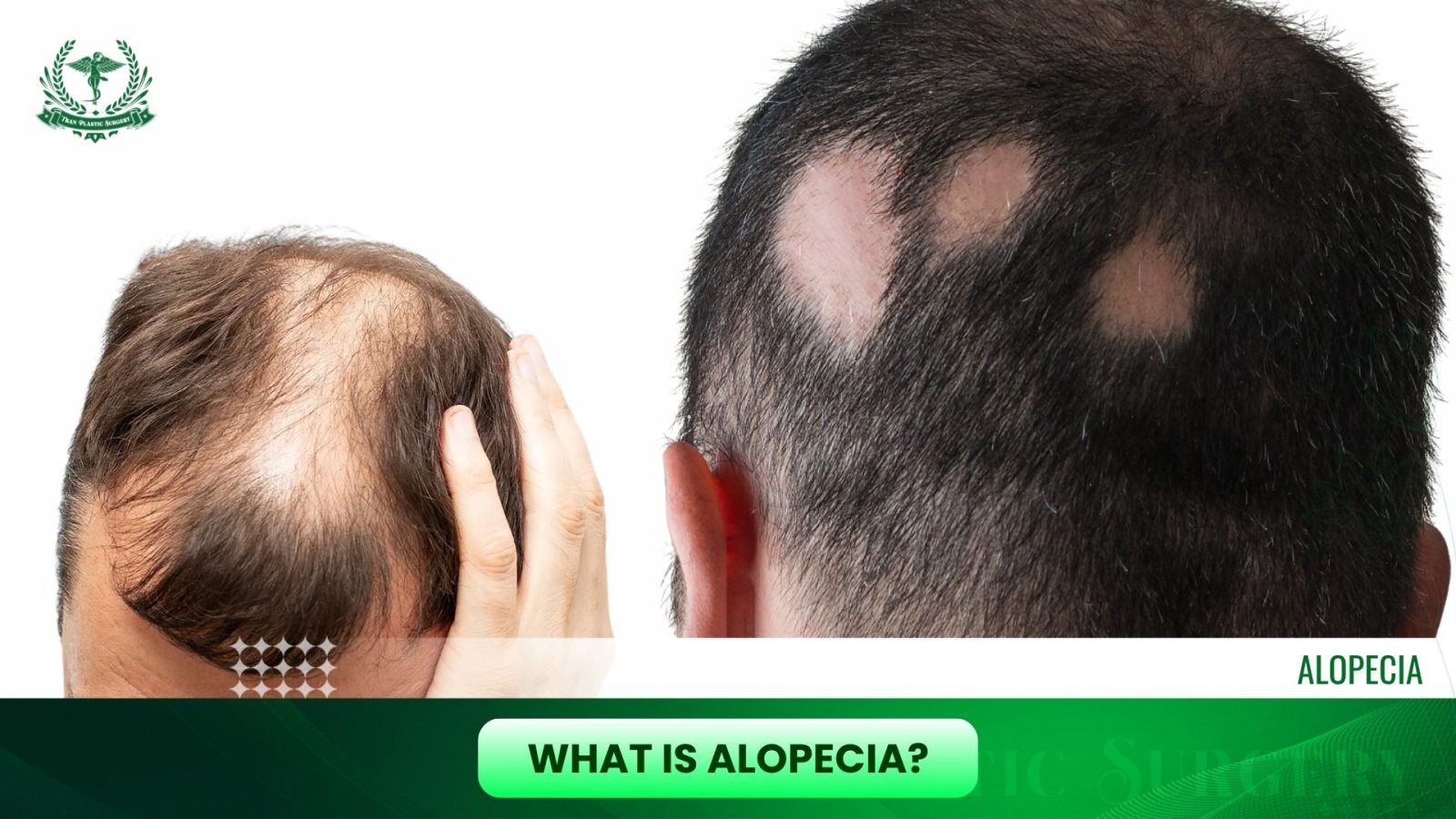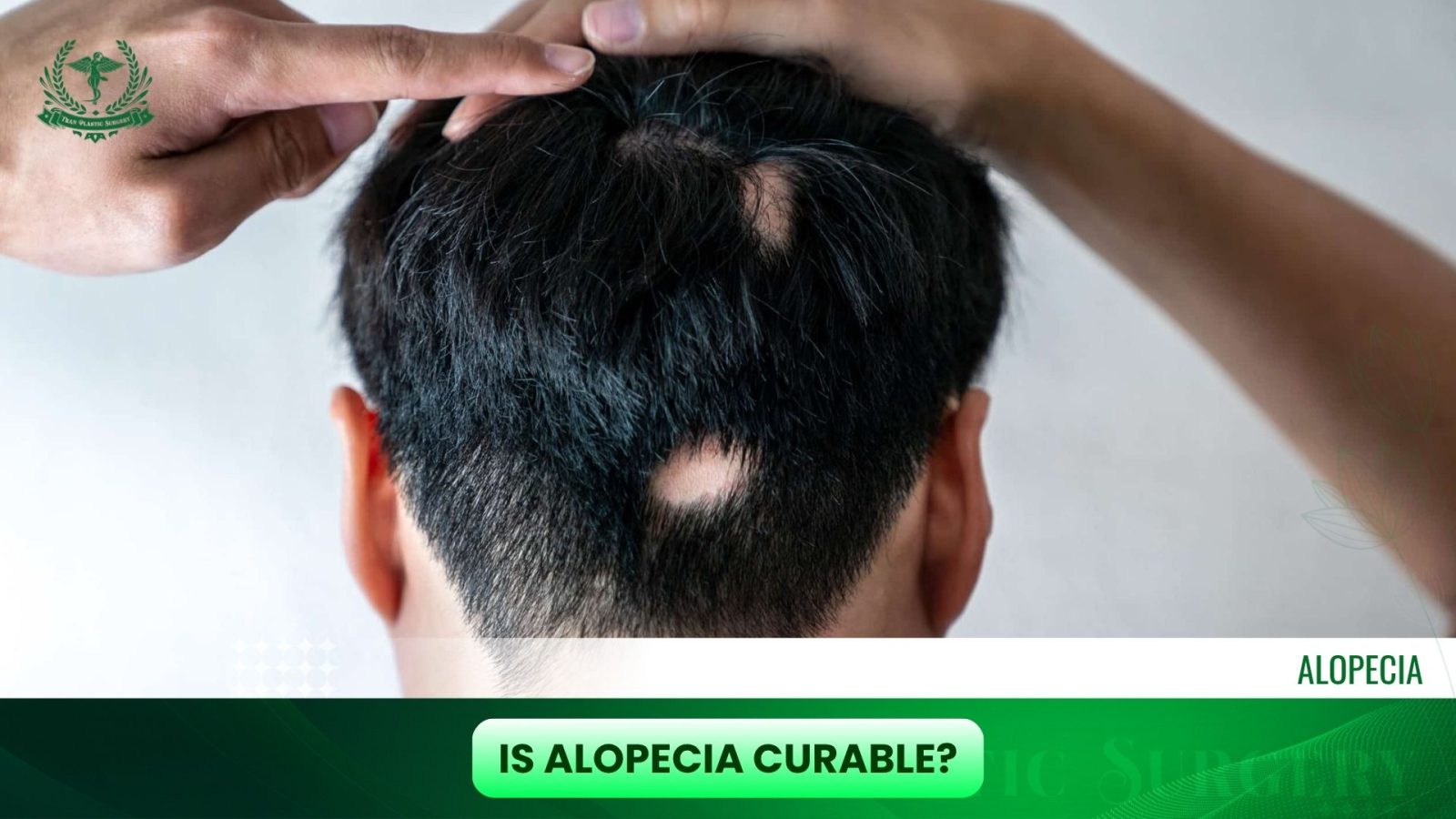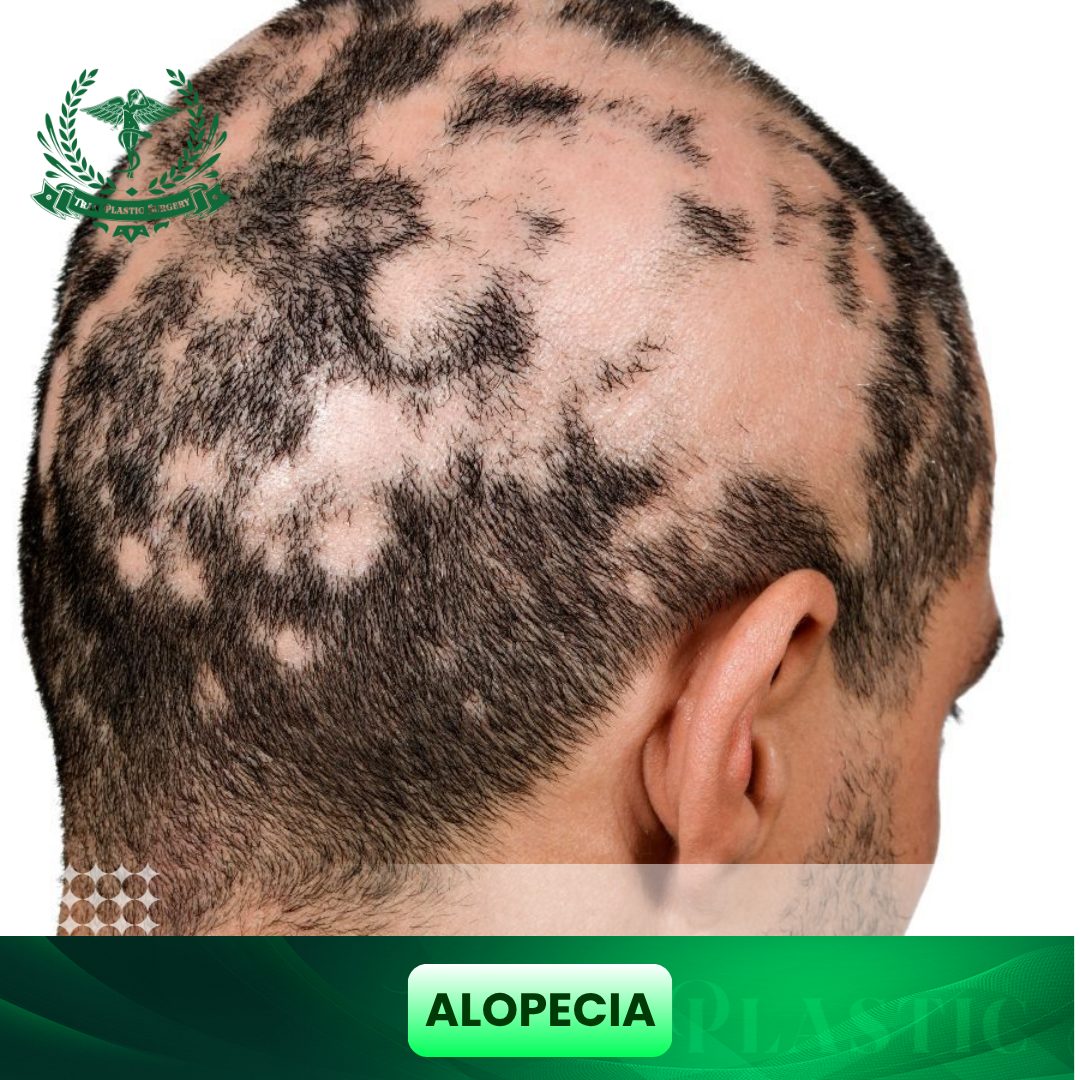Alopecia can be more than a cosmetic annoyance, it can affect your confidence, health and overall well-being. If you’ve noticed more hair falling out, thinning patches or sudden bald spots, you may be wondering what alopecia is and what you can do about it. In this article, we’ll explain what alopecia really means, explore what causes alopecia hair loss, and highlight natural steps you can take. When combined with expert evaluation at a clinic like Tran Plastic Surgery, you’ll have the best chance of maintaining healthier, fuller hair.
Table of Contents
ToggleWhat Is Alopecia?
Let’s begin with the basic question: what is alopecia? In simplest terms, alopecia refers to hair loss either in patches or more diffusely resulting from a variety of causes. It’s not a single disease but a term that encompasses multiple hair-loss conditions. The most common is alopecia areata, an autoimmune condition in which the immune system mistakenly attacks hair-follicle structures.

Other forms include androgenetic alopecia (pattern hair loss) and more extensive conditions such as alopecia totalis (loss of all scalp hair). What distinguishes alopecia from everyday shedding or thinning is the pattern, rapidity and often underlying health trigger.
>>> Read more: Hair Transplant Infection: Symptoms, Causes and Treatments
The Three Primary Clinical Types of Alopecia
Most cases of what is alopecia hair loss can be classified into three main non-scarring types. Dermatologists often begin clinical evaluation by analyzing the distribution of hair loss patchy, patterned, or diffuse. Understanding these categories is essential for identifying the underlying cause and guiding treatment.
1. Androgenetic Alopecia (AGA) / Pattern Hair Loss
Androgenetic alopecia (AGA), also called hereditary alopecia or pattern hair loss, is the most common form of hair thinning worldwide. It is a genetically influenced, hormone-mediated condition that causes progressive hair loss due to the miniaturization of hair follicles.
1.1. Male Pattern Hair Loss (MPHL)
In men, AGA is referred to as male pattern hair loss (MPHL). The primary driver is dihydrotestosterone (DHT), a hormone converted from testosterone. DHT affects susceptible hair follicles by shortening the active growth phase (anagen) and extending the resting phase (telogen), resulting in thinner, shorter, and lighter hair. MPHL typically appears as a receding hairline combined with thinning at the vertex and midfrontal scalp. Studies show that overexpression of androgen receptors (ARs) and elevated DHT formation in the scalp are key contributors to MPHL.
1.2. Female Pattern Hair Loss (FPHL)
Female pattern hair loss (FPHL) presents differently, usually as diffuse thinning on the crown while maintaining the frontal hairline. The causes of FPHL are more complex than in men. Although DHT sensitivity affects hair follicles, many women with FPHL have normal androgen levels. Genetics, age-related hormonal changes, and conditions like menopause, which reduce estrogen, may contribute to follicle shrinkage. Additionally, disorders that increase androgen levels, such as Polycystic Ovary Syndrome (PCOS), can trigger FPHL in younger women.
2. Alopecia Areata (AA)
Alopecia areata (AA) is a chronic autoimmune condition in which the immune system mistakenly attacks healthy hair follicles, causing hair loss. The hallmark of AA is sudden, patchy bald spots on the scalp or other areas, often without irritation, swelling, or redness. While the scalp is most commonly affected, AA can also impact eyebrows, eyelashes, and body hair. Nail changes, such as pitting, may accompany the condition.
AA is classified according to severity:
- Patchy Alopecia Areata: Localized bald spots.
- Alopecia Totalis: Total loss of scalp hair.
- Alopecia Universalis: Complete loss of hair on the scalp and body, a rare and severe form.
Understanding what causes alopecia in AA is essential for selecting the right management approach. While the condition can be unpredictable, early treatment may help reduce the duration and severity of hair loss.

3. Telogen Effluvium (TE)
Telogen effluvium (TE) is a type of diffuse, non-scarring hair loss that occurs when a significant stressor triggers a large number of hairs to prematurely enter the resting (telogen) phase. Unlike AGA, which is progressive, or AA, which is autoimmune, TE is usually temporary.
Common triggers include physiological or metabolic stress, illness, surgery, hormonal changes, or severe emotional stress (can stress cause alopecia). Once the underlying cause is addressed, hair typically regrows over several months to a year. TE is generally self-limiting, but proper management and how to treat alopecia with supportive nutrition, gentle hair care, and stress reduction can accelerate recovery.
Causes of Alopecia You May Not Know?
Understanding what causes alopecia requires examining the complex interplay of genetics, hormones, immune function, stress, nutrition, and environmental factors. Hair loss is rarely caused by a single factor; instead, multiple biological and lifestyle influences often converge to disrupt the normal hair cycle.
1. Genetic, Hormonal, and Autoimmune Drivers
The most fundamental causes of what is alopecia hair loss stem from core biological processes:
- Genetics: Hereditary factors strongly influence androgenetic alopecia (AGA), the most common form of pattern hair loss. Individuals with first-degree relatives experiencing hair thinning or baldness have a higher risk of developing AGA themselves.
- Hormonal Influence: In male pattern hair loss (MPHL), elevated sensitivity to dihydrotestosterone (DHT) drives follicular miniaturization and hair thinning. In women, what causes alopecia in women often involves a combination of genetics and hormonal changes. Around menopause, the sharp decline in estrogen affects approximately two-thirds of women, contributing to female pattern hair loss (FPHL). Additionally, conditions like Polycystic Ovary Syndrome (PCOS), which raise androgen levels, can trigger hair loss at younger ages, while many women with FPHL maintain normal androgen levels, highlighting the significant role of genetic predisposition and age-related hormonal shifts.
- Autoimmunity: Alopecia areata (AA) exemplifies hair loss caused by autoimmune activity. In AA, the immune system attacks healthy hair follicles, leading to sudden patchy bald spots. AA is frequently associated with systemic autoimmune disorders, including thyroid diseases (hypothyroidism or hyperthyroidism) and lupus. Recognizing the autoimmune link is crucial for effective treatment planning.
2. Stress and Physiological Triggers: The Telogen Effluvium Mechanism
Many people ask: can stress cause alopecia? The answer is yes, especially in cases of telogen effluvium (TE).
TE is a reactive, non-inflammatory hair-loss condition in which acute physical or psychological stress pushes a significant number of growing hairs into the resting (telogen) phase prematurely. This results in diffuse shedding that usually becomes noticeable two to four months after the triggering event. Because of this delay, patients may not immediately connect hair loss to the initiating stressor, which can include:
- Acute febrile illness or severe infection
- Major surgery, trauma, or hospitalization
- Postpartum hormonal shifts, particularly sudden estrogen drops
- Crash dieting, iron deficiency, or low protein intake
- Sudden discontinuation of estrogen-containing medications, such as birth control
While AA is primarily autoimmune, severe stress may act as a secondary trigger in predisposed individuals, potentially initiating an immune response that leads to hair loss.
3. Other Medical and Environmental Factors
Several additional medical and environmental factors can contribute to what causes alopecia:
- Medications: Anticoagulants, beta-blockers, retinoids (including excessive Vitamin A), and certain antidepressants may trigger hair shedding.
- Scalp infections: Conditions like tinea capitis (ringworm) can cause patchy alopecia accompanied by scaling or redness and require systemic treatment.
- Behavioral disorders: Trichotillomania, a compulsive hair-pulling disorder, produces distinct hair-loss patterns.
- Nutrition: Adequate intake of key nutrients such as iron, zinc, and protein is critical for hair follicle health. Generalized supplementation without evidence of deficiency can be harmful excess Vitamin A, for example, may paradoxically trigger hair loss. Nutritional strategies should always be guided by clinical assessment.
Identifying the root causes of hair loss is essential for how to treat alopecia effectively. By addressing the underlying biological, hormonal, immune, or lifestyle factors, individuals can optimize hair regrowth and prevent further thinning.

*Articles for you:
- Women’s Postpartum Hair Loss: Causes and Proper Treatment
- Hairline Restoration Treatments for Men and Women That Deliver Natural Results
Is Alopecia Curable?
One of the most common questions people ask is: is alopecia curable? Similarly, many wonder: can alopecia go away on its own? The answer depends on the type and underlying cause of hair loss.
For several forms of what is alopecia hair loss, particularly autoimmune types like alopecia areata, there is no guaranteed permanent cure. Hair may regrow spontaneously in some cases, but the condition can also recur or persist intermittently.
However, the outlook varies:
- Spontaneous regrowth: Some patients, especially those with mild or patchy alopecia, may experience full hair regrowth without medical intervention.
- Ongoing management: Others may need continuous monitoring and treatment to stabilize hair loss and prevent further thinning.
- Early detection matters: Identifying hair loss early and implementing a personalized treatment plan including medical therapies, natural approaches, and lifestyle adjustments can maximize the chance of regrowth and improve hair density.
At Tran Plastic Surgery, we emphasize realistic expectations. Our goal is not only to promote hair regrowth but also to restore confidence and minimize the risk of future thinning. By combining professional care with evidence-based strategies for how to treat alopecia, patients achieve the best outcomes for both hair restoration and overall well-being.

How To Tell If You Have Alopecia
Recognizing the early signs of what is alopecia hair loss is essential for timely intervention and effective management. Hair loss can be subtle at first, so understanding the typical patterns and symptoms helps you determine whether professional evaluation is necessary.
1. Common Signs of Alopecia
- One of the hallmark features of alopecia areata is sudden, round, or oval bald patches on the scalp or other areas, such as eyebrows or eyelashes. These spots are usually smooth, without redness or irritation.
- In female pattern hair loss (FPHL) or telogen effluvium (TE), hair thinning may appear across the scalp rather than in isolated patches. Women often notice widening of the central part or overall reduced hair volume.
- Typical of male pattern hair loss (MPHL), men may experience a gradually receding frontal hairline and thinning at the vertex or crown.
- Noticing more hair than usual in brushes, combs, or shower drains can indicate the onset of alopecia. Sudden shedding may be linked to telogen effluvium triggered by stress, illness, or hormonal changes.
- Miniaturization of hair follicles in pattern hair loss can result in finer, lighter, or shorter hairs over time.
- In some cases of alopecia areata, small dents or pitting may appear on the nails. Scalp infections or dermatologic conditions may cause redness, scaling, or flaking.
2. When to Seek Professional Help
If you notice any of the above signs or patterns of hair loss, it’s important to consult a specialist promptly. Early evaluation allows dermatologists or hair-loss experts to:
- Determine the underlying type of alopecia (what causes alopecia)
- Recommend appropriate medical treatments or lifestyle interventions (how to treat alopecia)
- Prevent further hair thinning and improve the likelihood of regrowth
By understanding how to tell if you have alopecia or How do you get alopecia? You can take proactive steps to protect your hair, enhance recovery, and maintain overall scalp health.
The Role of Specialist Assessment and Combination Therapy in Treating Alopecia
Understanding how to treat alopecia effectively often begins with a comprehensive evaluation by a qualified specialist. Hair loss is rarely caused by a single factor; genetics, hormones, immune responses, stress, nutrition, and environmental influences can all contribute. Professional assessment ensures that treatment addresses the root causes of what causes alopecia, rather than just the symptoms. A specialist, such as a dermatologist or hair restoration specialist at Tran Plastic Surgery, can provide:
- An accurate diagnosis of hair loss due to androgenetic alopecia, alopecia areata, telogen effluvium or other causes is essential for effective management.
- Treatment plans are individualized, each type of hair loss responds differently to interventions. A suitable treatment plan may combine medical therapies, lifestyle modifications and natural support strategies to maximize regrowth.
- Prompt assessment and early intervention can prevent further hair thinning, improve outcomes and reduce the psychological impact of hair loss.
Combination therapy involves integrating multiple treatment modalities to address the various factors contributing to hair loss:
- Medical treatments: Options such as topical minoxidil, oral medications, corticosteroids, or PRP (platelet-rich plasma) therapy can target the underlying causes of hair loss.
- Natural and lifestyle strategies: Nutritional optimization, stress management, gentle hair care, and essential oils may support hair regrowth and maintain scalp health.
- Procedural interventions: In selected cases, hair transplant surgery or laser therapy may be recommended for long-term restoration.
By combining these approaches, patients achieve better outcomes than relying on a single therapy alone. Integrating lifestyle support and evidence-based medical care addresses both the symptoms and underlying causes of what is alopecia hair loss, improving the likelihood of sustainable results.

At Tran Plastic Surgery, we emphasize a holistic approach that balances professional care with safe, natural strategies. This combination therapy ensures that treatment is tailored to the individual’s type of alopecia, overall health, and personal goals, enhancing both hair restoration and patient confidence.
Why Choose Tran Plastic Surgery for Alopecia & Hair Loss Care

Choosing the right medical team is paramount for successful hair restoration, particularly when dealing with complex conditions like alopecia. Tran Plastic Surgery’s approach is defined by its commitment to combining expert, board-certified care with personalized treatment strategies, ensuring optimal and natural-looking results.
- Expert, Board-Certified Care the foundation of the practice rests on the credentials and deep experience of Dr. Tran. His affiliations include being a Diplomate of the American Board of Plastic Surgery and an active member of professional bodies like The Aesthetic Society (ASAPS), demonstrating a commitment to the highest standards of aesthetic practice and continuous learning.
- Personalized, Comprehensive Approach Tran Plastic Surgery views hair restoration not just as a medical procedure, but as a path to transforming lives and enhancing confidence. For patients experiencing hair loss, this translates to a full spectrum of advanced, evidence-based options:
- Diagnosis and Strategy: Recognizing that a hair loss diagnosis is often distressing, the practice focuses on understanding the specific alopecia subtype whether it’s Androgenetic Alopecia, Alopecia Areata, or a result of trauma.
- Non-Surgical Solutions: Offering Platelet-Rich Plasma (PRP) therapy to stimulate natural hair growth for patients in the early stages of hair loss.
- Permanent Surgical Solutions: Utilizing advanced surgical techniques, such as FUE hair transplantation, for those with more advanced, permanent hair loss. Surgical restoration can be used for common pattern baldness and for hair loss caused by injuries or inflammatory diseases.
- Synergistic Treatment: Recommending combination therapies, such as using PRP to enhance healing and success rates alongside FUE transplantation, to achieve the fullest, healthiest results possible.
The team’s approach combines advanced techniques with a compassionate understanding, dedicating themselves to guiding patients on their aesthetic journey toward feeling their absolute best.
*References: https://www.ncbi.nlm.nih.gov/books/NBK538178/





